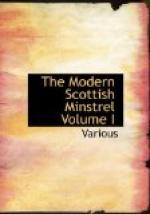Subsequent to her leaving Scotland, in 1784, Joanna Baillie did not return to her native kingdom, unless on occasional visits. On the marriage of her brother to a sister of the Lord Chief-Justice Denman, in 1791, she passed some years at Colchester; but she subsequently fixed her permanent habitation at Hampstead. Her mother died in 1806. At Hampstead, in the companionship of her only sister, whose virtues she has celebrated in one of her poems, and amidst the society of many of the more distinguished literary characters of the metropolis, she continued to enjoy a large amount of comfort and happiness. Her pecuniary means were sufficiently abundant, and rendered her entirely independent of the profits of her writings. Among her literary friends, one of the most valued was Sir Walter Scott, who, being introduced to her personal acquaintance on his visit to London in 1806, maintained with her an affectionate and lasting intimacy. The letters addressed to her are amongst the most interesting of his correspondence in his Memoir by his son-in-law. He evinced his estimation of her genius by frequently complimenting her in his works. In his “Epistle to William Erskine,” which forms the introduction to the third canto of “Marmion,” he thus generously eulogises his gifted friend:—
“Or, if to touch such
chord be thine,
Restore the ancient tragic
line,
And emulate the notes that
wrung
From the wild harp, which
silent hung
By silver Avon’s holy
shore,
Till twice a hundred years
roll’d o’er;
When she, the bold Enchantress,
came,
With fearless hand and heart
on flame!
From the pale willow snatch’d
the treasure,
And swept it with a kindred
measure,
Till Avon’s swans, while
rung the grove
With Montfort’s hate
and Basil’s love,
Awakening at the inspired
strain,
Deem’d their own Shakspeare
lived again.”




